

The United States alone has given more than 1 million artillery shells, according to a report from the Department of Defense. But the U.S. is not alone. Although not to that scale, European nations have been steadily aiding Ukraine’s defense efforts. Now other allied nations are starting to worry they won’t have enough armaments for their own self-defense. The Associated Press reported that European nations are worried about their arms supplies should Russian aggression reach them.
The war’s impact on American stockpiles has been a concern since September. At the time, the issue was whether or not the U.S. military has enough stockpiled ammunition to help it in a brutal, dragged out conventional war against a superpower like Russia or China. Now smaller nations near the Russian border, which are reliant on American arms, are publicly commenting on an internal dilemma: Do they continue to provide weapons as well to Ukraine, at the risk of their own, smaller militaries suffering as a result?
When the war started in February, American contributions to Ukraine’s military were not massive. But as the war has dragged on, so has the Ukrainian defense capabilities. Thanks to donations from the United States and other NATO member states, the Ukrainian military is now armed with a range of M1777 howitzers, Stinger and Javelin missiles, the High Mobility Artillery Rocket Systems (or HIMARS) weapons platforms and other explosives. And those are being put to use, as Ukraine pushes back and retakes Russia-controlled territory, leaving destroyed tanks and other equipment behind.
Other nations have also been giving military aid to Ukraine, but their capabilities are been stretched as well, due to having smaller militaries than the United States. The Associated Press spoke to several European officials, including Estonian Defense Minister Hanno Pevkur, who voiced their concerns over what the continued donations mean to their own forces. Pevkur said that nearly a third of its defense budget has gone toward aiding Ukraine. Similarly, according to the Kiel Institute, other nations made serious contributions; Slovenia, for instance, sent nearly 40 percent of its tank fleet.
Subscribe to Task & Purpose Today. Get the latest military news, entertainment, and gear in your inbox daily.
“Yes, the Bundeswehr’s stocks are limited. Just as it is the case in other European countries,” the German defense ministry told the Associated Press. It did not specify how much contributions to Ukraine have impacted its military stockpiles, but added that it is working to restock its supplies.
European nations are increasing their defense spending and trying to sign major arms deals to help meet demand amid tense security situations. However, much of that depends on the United States’ weapons output. Although American defense officials have been clear about the need to keep the Department of Defense’s supplies steady, the United States’ ability to get production going will impact other nations. Many buy equipment and munitions from the United States, so American production capabilities have a wider reach. Many of the donor nations had used Soviet-era weapons, compatible with much of what Ukraine uses, but they’ve burned through those supplies and are now reliant on modern American weapons systems.
Of course, NATO and other pro-Ukraine nations aren’t alone in their munitions woes. Russia has been going through its arms stockpiles in its effort to break the Ukrainian defenses. It got so bad that the heavily sanctioned nation has gone to Iran and North Korea to resupply.
The latest on Task & Purpose
- Orca submarine is yet another case of the Navy spending money like a drunken sailor
- What if the sailor charged in the Bonhomme Richard fire was actually a minor hero?
- Woke Army or Woe Army: What really happened in the social media controversy rocking the force?
- Watch a Ukrainian soldier take out a Russian cruise missile with a MANPADS
- The end of the brown beret: Air Force special ops squadron shuts down after 28 years advising allied aviators
Want to write for Task & Purpose? Click here. Or check out the latest stories on our homepage.
